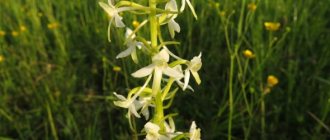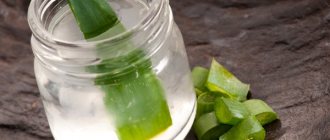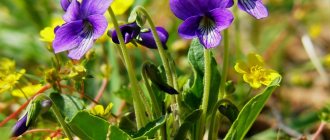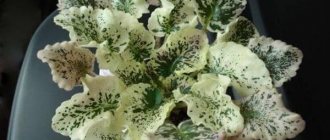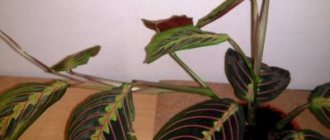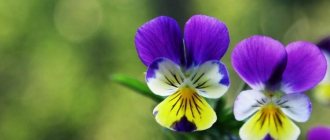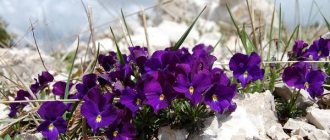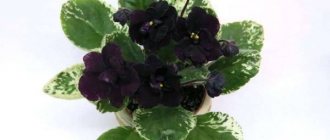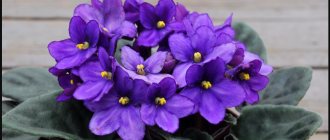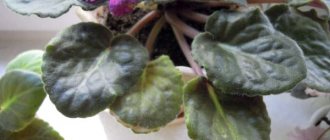In a garden bed or in a field you can find small, bright flowers of three colors. People call them pansies. The scientific name of the plant is tricolor violet or Violatricolor. Depending on the variety, it can be annual or biennial. The unpretentious viola in nature spreads like a weed, filling large areas. Thanks to the work of breeders, new varieties of violets with large flowers have appeared. In addition to its decorative appeal, the plant is known for its medicinal properties. Pansy herb has anti-inflammatory, bronchodilator and antimicrobial effects.
What it looks like and where it grows
The tricolor violet, or pansy, is a plant from the Violet family with an annual or biennial life cycle. It has a taproot, branched faceted stem, oval or ovoid green basal leaves.
From April until the end of summer it bears single flowers consisting of five petals, one pistil and five stamens. The upper petals are larger and are usually purple or dark blue. The middle ones are slightly smaller, yellow-white in color. There is a light spur on the lower petal. Closer to autumn, the plant bears fruits, oblong-shaped seed pods.
Tricolor violet rises up to 30 cm above the ground
The tricolor violet is widespread throughout the Northern Hemisphere. You can meet it in Western Europe, Sweden, on the territory of Russia - in the European part, in the Far East, in Crimea and Siberia. The flower chooses meadows, pastures, forest edges and old parks, roadsides and wastelands to grow.
Subspecies
There are five subspecies of Viola tricolor found in nature:
- Curtis subspecies Viola curtisi - grows in meadows and sand dunes of Great Britain and Ireland. The height of the perennial is 15 cm.
- Macedonian viola Viola macedonica - grows in Greece in the foothills of Olympus.
- Morning viola Viola matutina is native to Western Ukraine.
- Subalpine viola Viola saxatilis is an odorless perennial, common in the Alps and Pyrenees. Flowers 2-3 cm.
- Viola tricolor Viola tricolor subsp. Tricolor - in Europe the subspecies is called "Jumping Johnny", an annual up to 20 cm high.
Information. In Russia, it was believed that pansies should not be planted in front gardens; these are flowers for the cemetery.
Chemical composition of violet tricolor
Photos, medicinal properties and contraindications of tricolor violet deserve close attention. The leaves and flowers of the plant contain many useful substances, namely:
- glycosides and alkaloids;
- tannins;
- antioxidants;
- tannins and saponins;
- polysaccharides;
- ursulic acid;
- vitamin C;
- flavonoids;
- essential oils;
- mineral salts.
Tricolor violet should be used in small dosages, since many substances in its composition are potentially toxic. However, when used carefully, it has a beneficial effect on health.
Possible problems in growing
There are several contraindications that relate to cultivation. The flower, by its appearance, will give clues regarding further actions. Sometimes there are problems with leaves, diseases and insects. But these are rare and isolated cases.
Features of cultivation
What do problems with leaves mean?
The appearance of a leaf can indicate many things:
- yellowing - excess moisture;
- drying of the tips - insufficient irrigation;
- folding - the need to fertilize the soil.
Important! Other signals from the leaves may be associated with an incorrectly selected planting site.
Diseases
The common violet often succumbs to diseases associated with rotting of the root system. In addition, it can be affected by powdery mildew and gray rot. Tricolor is more resistant to any type of disease.
Pests
Bushes are rarely attacked by pests. Sometimes ants can live between the roots. The spider can spin a web between specimens - a common phenomenon for outdoor flowers.
Plant resistance to diseases and pests
Other problems
With the indoor version of the flower, problems may arise in terms of cultivation, breeding and care. Diseases often appear. Outdoor specimens are more resistant to weather conditions, harsh climates and external factors.
Triflower herb is considered medicinal and is often used in many areas of cosmetology. Previously, the plant was very popular among healers and physicians. Now many hybrids have been bred that are only superficially similar to the wild “ancestors”. Such specimens are resistant to weather conditions, diseases and pests. The aesthetic appearance captivates flower growers. The three-color color scheme is especially attractive.
What are the benefits of pansy flowers?
When used according to proven recipes, tricolor violet improves well-being and helps cure diseases. In particular, the plant:
- has choleretic properties and helps with cholecystitis;
- relieves inflammation of any nature;
- improves the condition of asthmatic cough and allergic rhinitis;
- fights skin rashes;
- promotes expectoration during ARVI, influenza and bronchitis;
- cleanses the lungs during pneumonia and during the period of quitting smoking;
- improves intestinal motility and gastric juice production;
- has a calming effect and strengthens memory;
- helps cope with insomnia and stress;
- reduces cholesterol levels in the blood and strengthens blood vessels;
- serves as a prevention of heart disease;
- accelerates skin and tissue regeneration;
- increases immunity.
The benefits of pansies for the body affect the reproductive sphere. You can use tricolor violet to restore hormonal levels and in the treatment of infertility.
Violet, don't worry!
Tricolor, like perennial garden violet, are susceptible to root rot and powdery mildew.
This is what stem rot looks like on a plant
Stem and root rot : weakened “kids” and adult plants after wintering suffer from the disease.
Signs: if you notice white parts of the stem, rotting brown spots - this is stem rot!
Treatment: remove the affected parts of the plant, reduce watering (most likely, you overdid it), fill the ground around the plants with crushed coal, perlite or calcined sand.
In the photo - powdery mildew
Powdery mildew . The disease is easily recognized by the white coating on the petioles, stems and leaves. I saved my flowerbed by spraying Bordeaux mixture (1%).
Methods of preparation and use
Based on tricolor violet, you can make teas and decoctions, as well as strong alcohol tinctures. With any processing method, the maximum amount of useful substances in medicinal raw materials is preserved.
Tea
Pansy flowers are used to make tea. The recipe looks like this:
- a small spoon of raw material is poured with 300 ml of boiling water;
- cover the container with a lid;
- leave for 15 minutes and filter.
Also, the petals of the plant can be added to green or black tea leaves.
We recommend reading: Mint tea: beneficial properties and contraindications, how to make
Violet tea has a tonic effect and helps strengthen the immune system.
We recommend reading: Tea with thyme: beneficial properties and contraindications
Infusion
A water infusion based on pansies is made as follows:
- a large spoonful of dried flowers and leaves is crushed;
- pour 400 ml of hot water;
- cover with a lid and leave until cool.
The finished product is passed through gauze and consumed 100 ml up to three times a day.
An infusion of tricolor violet can be drunk to improve digestion.
Tincture
The healing properties of pansies are fully revealed in a strong tincture. It is prepared like this:
- 30 g of flowers and leaves are placed in a glass jar;
- pour 500 ml of vodka;
- shake and put away in a dark place for two weeks.
The finished product must be filtered. Take the medicine 30 drops up to three times a day, diluting the tincture in a small amount of water.
Tricolor violet tincture can be used externally
Decoction
For intestinal disorders and inflammations, a decoction of tricolor violet is beneficial. The recipe looks like this:
- dry roots and leaves of pansies are mixed;
- measure out 20 g of raw material and pour in 500 ml of liquid;
- Boil in a water bath for 50 minutes;
- leave for two hours and filter.
Since the product is highly concentrated, use only 50 ml three times a day.
A decoction of tricolor violet is consumed on an empty stomach shortly before meals.
Important! A decoction of the plant can be used to wipe the skin for irritations and cuts; it has strong antiseptic properties.
Planting violas Peculiarities
If you plant pansies without following the rules relating to a particular variety, then you may not expect flowering in the first year.
Planting in the ground should be done only when the seedlings have become strong and fully formed.
As a rule, seedlings are grown at home, starting from late February - early March.
Planting seeds directly depends on the climatic conditions of your region. Therefore, this factor must be taken into account.
Before you start seedlings, study all the information for your region. It happens that some varieties may not be suitable at all for a particular climate zone.
General recommendations:
- Prepare the correct soil.
Pansies do not like acidic soil. Therefore, prepare in advance suitable containers with a slightly acidic soil reaction. The earth needs to be moistened, but without enthusiasm. Subsequently, it is also recommended to ensure that there is no overflow.
Viola seeds are sown in furrows and covered with soil of a small thickness of 4-5 mm.
The small thickness will allow you not to miss the first shoots, which will appear in 4-6 days.
- Monitor the temperature.
Seedlings love cool conditions at temperatures from +17 to +20 C. A few days later, as soon as the first shoots appear, lower the temperature to +13 - +17 C.
- Feed the seedlings.
Fertilizers must be applied during plant growth. You can use an instant fertilizer containing nitrogen, phosphorus and potassium.
- Picking seedlings.
After a short germination, the seedlings must be transplanted into cassettes with a cell diameter of no more than 7 cm.
The timing of the dive depends on the time of appearance of the first two leaves. Not earlier! If there is a need for seating in parts, this is acceptable.
After transplanting, place the finished cassettes with violets in a cool place with a temperature of +10 to +13 C.
As a rule, to ensure such temperature conditions, cassettes with seedlings are placed in a greenhouse. But if you don’t have this opportunity, then a veranda, balcony or window sill will do.
After diving, continue fertilizing following the instructions on the fertilizer package.
- Landing in the ground.
Transplantation of established seedlings is carried out approximately 2 months from the date of first sowing. The timing of the final transplant depends on the variety and condition of the plant.
Plant seedlings at a distance of 10–20 cm from each other, as too close proximity can lead to rotting of the root system and the plant itself.
How to determine whether seedlings are ready for transplanting or not?
As a rule, gardeners look at the number of leaves. On strong, fully formed seedlings there should be at least 4 of them.
In some situations, it is possible to transplant into the ground already at the flowering stage. It's even better for violets.
If everything described above is too complicated for you and is not completely clear, then use garden varieties of tricolor violets.
Such violas do not require intermediate transplantation (diving) into cassettes. Planting in the ground can be done after the first two leaves appear.
Choosing a landing site
It is necessary to plan the place where you plan to plant pansies in advance - even at the stage of choosing a variety.
Some species can grow in the sun and in the shade, and some of them do not like shade at all. But, for the most part, violas prefer well-lit, warm areas. Choose a place where there is sunlight for at least 6 hours a day.
Choose places with shade or partial shade only if the plant variety allows it. During preparatory work, do not add additional fertilizer to the soil. It is enough to choose an area with fertile soil and loosen it well.
Care
If you have chosen the right place, according to the viola variety, and maintain the required level of soil moisture, then the plants will delight you with their lush, beautiful flowering throughout the warm season.
Pansies do not require regular watering. The most important thing is that the soil is always moist. But there shouldn’t be any overflow. That is why, when choosing a landing site, make sure that rainwater does not accumulate or stand there.
If there is a dry spell, water the plants regularly, otherwise they will shrink in size or stop blooming altogether.
Some varieties of viola require additional feeding. If this is necessary for the species you have chosen, then fertilizing the soil only needs to be done twice during the entire season.
Any drugs can be used. The most important thing is that they are suitable for the violets that you plan to breed.
The first feeding is carried out before flowering - during budding. The second is carried out when the violets bloom.
After flowering begins, make sure that there are no weeds, as they can become intermediaries in the transmission of various diseases and infections. Weed regularly.
After flowering ends, when there are practically no leaves left on the plant, cover them with straw, spruce branches, or fallen leaves.
A similar procedure is carried out only for perennial plants. If you planted annual varieties, or varieties that do not require insulation, then there is no need to carry out the procedure.
Carefully study the information about the selected variety.
Pansies in medicine
Traditional medicine suggests using the medicinal properties of wild pansies for colds, skin and digestive diseases. There are several proven recipes for using tricolor violet.
When coughing
The medicinal properties of pansies promote expectoration and relieve inflammation during bronchitis, pneumonia, tuberculosis and common colds. For medicinal purposes, you can prepare the following infusion:
- 10 g of violet herb is mixed with an equal amount of plantain leaves;
- add 5 g of dried coltsfoot;
- pour the collection with 500 ml of boiling water in a thermos;
- keep covered for two hours.
You need to drink the infusion four times a day, 100 ml on an empty stomach.
For urticaria
The following home remedy helps with allergic skin rashes in children and adults:
- pour a large spoon of dry plant into 1 liter of boiling water;
- leave covered for 40 minutes;
- passed through cheesecloth for filtration.
The product must be taken throughout the day in small portions at intervals of two hours. In total, treatment is continued for up to three days. Pansies are especially good for helping with food allergies.
An infusion of tricolor violet is not used for diarrhea - the herb has a laxative effect
For wounds and cuts
The beneficial properties of pansies in combination with other plants have a good healing effect and promote rapid regeneration of the epidermis. Traditional medicine suggests using the following remedy:
- 20 g of tricolor violet are mixed with an equal volume of string;
- add 10 g of calendula and chamomile;
- pour 2 liters of water over the herbs and boil for half an hour;
- cool and filter the solution.
It is necessary to wipe the affected areas of the skin with the infusion several times a day. The product can also be added to medicinal baths.
Advice! When using tricolor violet infusion for children, it is first diluted with clean water in a 1:1 ratio.
For gastritis
Tricolor violet contains components that suppress Helicobacter, the causative agent of gastritis. For stomach irritation, it is useful to use the following herbal infusion:
- two large spoons of dry leaves and flowers are poured into 1 liter of hot water;
- keep covered for about an hour;
- the cooled product is passed through gauze.
The infusion should be taken warm on an empty stomach three times a day, 80 ml. The maximum duration of therapy is two months, after which they take a break for a month and repeat the course if necessary.
For liver diseases
Tricolor violet helps cleanse the liver, relieves inflammation and promotes restoration of the organ. Usually, fresh pansy juice is used for medicinal purposes. The remedy is made like this:
- several leaves of the plant are crushed into pulp;
- squeeze through cheesecloth to obtain liquid.
You need to take the medicine three times a day, a small spoon on an empty stomach. In total, treatment is continued for two weeks.
Important! For liver diseases, the usual infusion of violet is also beneficial. In a volume of 100 ml it is taken on an empty stomach for a month in a warm form.
For a cold
Tricolor violet has an antiviral effect, prevents the proliferation of microbes and reduces temperature. You can use products based on it at the first sign of a cold to relieve nasal congestion and cough.
Hot tea has a good effect on ARVI and flu. They do it like this:
- two large spoons of dried flowers and leaves of the plant are poured with 300 ml of boiling water;
- leave in a teapot covered for 15 minutes;
- pass through a fine sieve.
If you have a cold, you can drink up to six cups of the medicine a day. The medicinal properties of field pansies will help you quickly cope with viruses and bacteria.
For colds, tricolor violet tea helps relieve symptoms of general intoxication
For rheumatism
The anti-inflammatory properties of tricolor violet are used in the treatment of rheumatism. To eliminate pain and swelling, compresses based on alcohol tincture are used; it is made from the roots of the plant and kept for at least 20 days in a dark place. On a daily basis, you need to put lotions with the medicine for at least half an hour to quickly relieve the inflammatory process.
Also, for medicinal purposes, a strong decoction of the plant is used, gauze is soaked in it and applied to the sore spot for 40-50 minutes. The compress should be warm so that the active components penetrate the tissues through the skin faster.
For chronic fatigue
For stress, fatigue and anxiety, you can use the following collection of medicinal plants:
- pansies are mixed with medicinal veronica herb in equal proportions;
- measure out a small spoon of raw materials and pour in 250 ml of boiling water;
- stand for 3 minutes and filter.
Take a glass of the product up to three times a day. To enhance its medicinal properties, you can add a little honey, which also has a beneficial effect on the nervous system.
Medicinal properties of the herb
In the 11th century, in one of the medicinal treatises of Odo of Mena, it was written about the medicinal properties of grass and flowers:
If you apply grated ones, they will help inflamed areas; If you drink, the hops will be driven away, and a heavy head will be treated Only with the aroma of a flower, or with a crown of violets; If you soak them in water and drink them, your gums will be healed. Its grated roots, combined with vinegar, dry the spleen: they drink them or apply them to the area; In this way, they say, hot gout is also treated. Thus, in children it relieves both cough and shortness of breath. According to Pliny, it has the properties of licorice.
The herb contains anthocyanins, carotenoids, ascorbic acid, flavonoids, saponins, polysaccharides, tannins, essential oil containing methyl salicylate, it also contains potassium, calcium, magnesium, iron, trace elements - manganese, copper, cobalt, molybdenum, chromium and others.
It has anti-inflammatory properties, which are associated with the presence of essential oil and mucus-like substances in it, which enhance the secretion of the bronchial glands and facilitate the secretion of sputum, which have an antiseptic effect in the gastrointestinal tract. It is mainly used in medicine as an expectorant and cough softener for acute respiratory diseases, chronic bronchitis and bronchopneumonia, and whooping cough.
Violet herb has a diuretic and diaphoretic effect, improves metabolism, is used for inflammatory diseases of the kidneys and bladder, for kidney stones, for joint diseases, as well as in dermatology - for urticaria, non-healing wounds, trophic ulcers, even for skin cancer , for eczema, furunculosis, diathesis and various rashes.
Application for weight loss
Tricolor violet is often used on a diet - the plant stimulates metabolic processes, but reduces appetite and makes it easier to tolerate dietary restrictions. With the use of medicinal herbs, the breakdown of fats in the body accelerates, and excess weight disappears faster.
For dietary purposes, use the following infusion:
- a small spoonful of herbs is brewed with a glass of boiling water;
- keep the product covered for half an hour;
- strain from the sediment.
Instructions for use of tricolor violet recommend taking the infusion warm 40 minutes after eating. Each time a fresh portion of the product is prepared for use.
Growing on site
If you managed to collect violet seeds, you can grow them in your garden. Pansies are very unpretentious, and once you start them, they will persistently spread by self-sowing. For violets, an open or slightly shaded area and medium-moist soil rich in organic matter are suitable. When preparing the site, apply at least 3-4 kg/m2 of organic fertilizers.
Reproduction
Seeds are sown in the ground superficially, lightly embedding them into the soil with a rake, and on light soils - to a depth of 0.5-1 cm, with row spacing of 30-40 cm. Pansies can be sown at several times: in early spring, summer, and winter. (last ten days of August) and before winter. In the first two cases, the plant blooms in the same year. When sown in winter, violets begin to bloom the next year in early spring, which turns out to be very useful in a dull area after winter.
Care
Maintenance is the simplest and consists of weeding, loosening and, if necessary, watering. It makes no sense to feed plants - they develop so quickly that fertilizers do not have time to be absorbed. It is better, as mentioned above, to refill the soil before sowing. After cutting the raw material, the violet quickly grows back and again pleases the eye with abundant flowering. But if you let it form seeds, then Pansies quickly lose their decorative qualities.
The seeds are collected gradually, picking off the capsules slightly unripe. The collected boxes are laid out on paper. When dried, they crack and the seeds spill out.
Medicinal raw materials
Violet or Pansy grass is harvested during flowering, mainly in May-July. It is cut with knives and sickles, but not torn off, since in this case the plants are pulled out by the roots and soil gets into the raw material. The collected raw materials are dried in a place protected from the sun and wind, laid out in a layer of 5-7 cm on paper or canvas and stirred periodically. In good weather it dries in 5-7 days. Shelf life 1.5 years.
Chemical composition
Active ingredients
Violet herb contains polysaccharides, 0.01% essential oil (it contains salicylic acid methyl ester), up to 14% triterpene saponins, phenol carbonic acids, coumarins, tannins, 2.1% flavonoids, vitamins (C, P, E) and carotene (provitamin A).
Application in cosmetology
Tricolor violet has a beneficial effect on skin and hair. The plant is used for seborrhea and peeling of the epidermis on the head, for blackheads and pimples:
- An infusion of the annual can be used to wipe the skin twice a day; a strong decoction is used for compresses and steaming three times a week. The tincture is suitable for spot treatment of inflammation; pimples and ulcers disappear in a couple of days.
- You can make a rinse for oily hair using pansies. If you wash your hair with it up to three times a week after regular hygiene procedures, your hair will acquire a healthy shine and will get dirty more slowly.
- A decoction of tricolor violet is suitable for caring for nails and cuticles. It is necessary to boil two large spoons of raw material in 1 liter of water, and when the product has cooled, hold your fingertips in it for 15 minutes.
For weakened hair and dry skin, homemade violet tricolor oil helps. When warm, it is applied both to the face and to the root zone of the head and lightly rubbed in, and after 20 minutes, washed off using mild soap or shampoo. The product has a restorative and moisturizing effect, improves local blood circulation.
Violet oil is used in massage and added to creams
Most popular varieties
Among the pansies that received the greatest popular love are: Freedom, Blueberries with cream, Viola Aurora, Waterfall, Velor, Wittrock Alpensee, Empire, Russian beauties, Evening heat, Ice King, Weiss, Eye of the Tiger, Adonis.
Let's look at each of them in more detail.
Blueberries with cream
This violet is one of the low-growing ones. Its height reaches only 15 cm.
The flower color is dark purple with white edges. This color scheme looks very impressive, which is why such violets are often used to decorate flower beds and borders in urban spaces.
They are also very easy to care for and can withstand low temperatures.
They require loose soil. Planting is done in well-lit areas.
Freedom
This is a small-flowered variety. The diameter of the flowers reaches only 5 cm. The violets fit tightly to each other and grow well. The Freedom variety is unpretentious, frost-resistant and very hardy in the face of adverse weather conditions. It tolerates heat and prolonged downpours better than other representatives of its subspecies (with small flowers).
As a rule, Freedom is grown in combination with other spring flowers.
These violets are not very demanding in terms of care, but they need regular watering and a well-lit place. To ensure denser blooms, it is necessary to remove dried flowers.
Waterfall
This variety is ampelous (violets with long hanging stems), and it is popular in vertical gardening.
This viola is usually grown in hanging pots or containers.
The color scheme of the petals is golden. The size of the flowers reaches 5 cm. It begins to bloom in May and ends in early autumn.
The Waterfall variety is resistant to frost and loves sunlight. The soil under the plant must be constantly moist.
Viola Aurora
This variety is a highly branching compact bush. Reaches a height of 25 cm.
Viola Aurora blooms very profusely. The size of the flower reaches 7 cm. The color of the violet is characterized by variability depending on temperature and lighting.
The viola's petals are corrugated and have a border around the edges. As a rule, it is grown on balconies, but can often be found decorating urban spaces.
Aurora prefers fertile, drained soil. Grows equally well in sun and partial shade.
Wittrock Alpensee
This type of pansy is low. The bushes hardly reach a height of 15 cm.
This violet is unpretentious to conditions, easily tolerating slight drops in temperature. Blooms from May to October, prefers sunny areas and good watering. Most often this variety is grown in balcony containers and garden vases.
Velours
This variety is characterized by small - 20 centimeter bushes with a diameter of about 30 cm. The flowers themselves are small, but due to their close proximity to each other they form a beautiful flower ball. The color is bright and rich.
Velor urgently needs drained soil with high breathability. Grows in both sun and partial shade.
Viola “Velour” is unpretentious and easily tolerates adverse weather conditions. Used as decoration for alpine slides and borders.
Empire style
Refers to a species with large flowers of 10 cm. It is an exclusively decorative variety. Has bright colors. Requires regular and moderate watering.
If conditions are created under which the temperature stays around +16 degrees, then the plant will delight you with very large flowers.
Ice King
This violet grows up to 20 cm in height. The color is white with a slight green tint. The lower petals are decorated with purple spots.
Evening heat
It is appreciated by gardeners as a very beautiful flowering plant. The diameter of the flowers is 5-6 cm, each of which is located on a long peduncle reaching 10 cm.
The flowers are red with a brown tint. Darker spots of the same color can be seen on the petals.
The edges of the petals are wavy. Plant height is 10-15 cm.
Russian beauty
Violets of this variety produce fairly large flowers, reaching a diameter of 8-9 cm.
The bushes themselves are low - about 15 cm. They are unpretentious in care, and can grow even in conditions of a lack of land.
Resistant to cold, grows both in the sun and in the shade.
Weiss
The bush grows up to 25 cm, which is very high for a violet. The flowers reach a diameter of 7 cm.
The color is white with a yellow center. The edges of the petals are wavy.
Adonis
Viola with the fastest and longest flowering. Refers to a species with large flowers. But the bushes themselves are small. The height is only 15 cm. The two upper petals are blue, the lower ones have white and purple spots. As a rule, it is planted in groups.
Tiger's Eye
Medium sized bush. The height, as a rule, is no more than 20 cm. The color scheme is very unusual. Externally, the color resembles a tiger's eye.
It grows into a lush velvet carpet.
The flowers are small in size, 3-4 cm, yellow with textured black stripes.
Tolerates any type of soil provided there is good water permeability and effective drainage.
Contraindications to the use of tricolor violet
The medicinal properties and contraindications of the tricolor violet herb are closely related to each other. In some conditions, the use of plant raw materials should be abandoned. In particular, pansies can damage:
- with jaundice and severe liver failure;
- for acute kidney inflammation;
- with severe urolithiasis;
- during pregnancy and feeding;
- for individual allergies.
The benefits and harms of pansies are controversial for diabetics. The plant can lower blood sugar levels, but you should consult a doctor before using it so that the effect is not too strong.
general information
Pansies came to us from Europe, and spread throughout the globe from Asia to the Western part of our continent. Viola belongs to the violet family. These plants have a rod shape, and their stem reaches a height of up to 35 cm. Viola buds are usually single.
In the wild, flowers grow like weeds and do not add any aesthetics or beauty to the place where they grow.
Surprisingly, some species of these plants are able to bloom even in cold climates.
Collection and preparation
All parts of pansies can be used for medicinal purposes, but the optimal time for collecting raw materials will vary. The roots of tricolor violet are dug up in autumn or early spring, when they contain the most useful substances. Flowers are harvested at the peak of their decorative value, and leaves can be collected throughout the summer.
It is recommended to dry tricolor violet outdoors under a canopy or in a dry, ventilated area. For quick processing, roots can be placed in the oven preheated to 40 °C
Violet leaves and buds are dried only in air - the active substances in them are destroyed in the oven
After processing, dried pansies are laid out in paper bags and stored in a dark place with low humidity. The raw materials retain their beneficial properties throughout the year, so it is recommended to renew medicinal supplies every season.
Description field violet
This is another very common related species - Viola arvensis Murr.
If the plant has large, dark purple or blue, tricolor flowers, it is a tricolor violet. If the flowers are small, their upper petals are white, and the lower petals are yellow with a brown eye in the middle and thin veins - this is a field violet, it has the same medicinal properties. It also grows everywhere and is used along with the tricolor one.
Both types are harvested for medicinal purposes. The grass is harvested during flowering from May to August. The entire aerial part is used, the plant is cut with a knife or scissors.
Dry by hanging in bunches or spreading in a thin layer 5-7 cm thick on paper or linen in a ventilated area; It is allowed to dry in ovens at a temperature not exceeding 40 degrees, dry until the stems become brittle. The color of the raw material is dark green, the taste is sweet and slimy. Dried grass can be stored for 1.5 years.
"Beauty requires sacrifice"
Delicate tricolor violet helps not only get rid of diseases, but also improve your appearance. The components of the plant work real miracles on the skin of the face and scalp. For example, simple tinctures are prepared to treat seborrhea. For 250 g of boiling water you will need 2 teaspoons of dry herbs. The mixture is stirred and left for 30 minutes. Wipe the affected areas of the skin with the liquid 2 times a day. An alcohol tincture is prepared from 2 tablespoons of dried violet flowers and 200 ml of 70% alcohol. The liquid is infused for 2 weeks. Used to treat all kinds of skin irritations.
Having studied in detail the medicinal properties of tricolor violet and the contraindications of the plant’s components for the body, we understand the value of the delicate flower. Its chemical formula contains a number of unique compounds. Thanks to this, drugs obtained from the leaves, buds and roots of the plant have a beneficial effect on the body. Using proven recipes for medicinal drinks and tinctures, we will learn how to prepare them at home. When taking drugs, let’s not forget about possible contraindications.
Meaning in nature and in human life
- Around Ancient Rome and Athens there were many meadows and lawns with violets. They were more like plantations: The inhabitants of Rome used them as a remedy. And he added it to the wine;
- In Sicily, coins were depicted with an alto;
- The ancient Gauls considered them a symbol of innocence and modesty;
- The violet is Empress Josephine's favorite flower.
Tricolor viola - flower of Jupiter.
